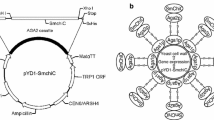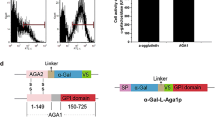Abstract
Pediocin PA-1 is a bacteriocin that shows strongly anti-microbial activity against some Gram-positive pathogens such as Listeria monocytogenes, Staphylococcus aureus, and Enterococcus faecalis. With the broad inhibitory spectrum as well as high-temperature stability, pediocin has a potential application in the food preservation and pharmaceutical industry. Pediocin has been studied to express in many heterologous expression systems such as Escherichia coli, Saccharomyces cerevisiae, and Pichia pastoris as a free peptide. Here we showed in this study a new strategy by using yeast surface display system to produce the anchored pediocin PA-1 on the cell surface of Saccharomyces cerevisiae, which could be used directly as a pediocin resource. We had successfully constructed a recombinant S. cerevisiae W303 strain that could express pediocin PA-1 on the cell surface. The pediocin-expressing yeast could inhibit the growth of Shigella boydii and Shigella flexneri, which have never been reported before for pediocin activity. Besides, the pediocin expression level of the recombinant S. cerevisiae strain was also evaluated in three different media: synthetic defined (SD), basic medium (BM), and fermentation medium (FM). BM medium was shown to give the highest production yield of the recombinant yeast (4.75 ± 0.75 g dry cell weight per 1 L of culture) with the ratio number of the pediocin-expressing cells of 93.46 ± 2.45%. Taken together, the results clearly showed that pediocin can be displayed on yeast cell surface as anchored protein. The application of yeast cell surface system enables a new door of pediocin application on either food or feed industries.

Graphical abstract




Similar content being viewed by others
References
Beaulieu L, Groleau D, Miguez CB, Jetté J-F, Aomari H, Subirade M (2005) Production of pediocin PA-1 in the methylotrophic yeast Pichia pastoris reveals unexpected inhibition of its biological activity due to the presence of collagen-like material. Protein Expr Purif 43:111–125
Beaulieu L, Tolkatchev D, Jette J-F, Groleau D, Subirade M (2007) Production of active pediocin PA-1 in Escherichia coli using a thioredoxin gene fusion expression approach: cloning, expression, purification, and characterization. Can J Microbiol 53:1246–1258
Bédard F, Hammami R, Zirah S, Rebuffat S, Fliss I, Biron E (2018) Synthesis, antimicrobial activity and conformational analysis of the class IIa bacteriocin pediocin PA-1 and analogs thereof. Sci Rep 8:9029
Bimboim H, Doly J (1979) A rapid alkaline extraction procedure for screening recombinant plasmid DNA. Nucleic Acids Res 7:1513–1523
Chen C, Sebranek JG, Dickson JS, Mendonca AF (2005) Combining Pediocin (ALTA™ 2341) with thermal pasteurization for control of Listeria monocytogenes on Frankfurters. Anim Ind Rep 651:62
Drider D, Fimland G, Héchard Y, McMullen LM, Prévost H (2006) The continuing story of class IIa bacteriocins. Microbiol Mol Biol Rev 70:564–582
Ennahar S, Sashihara T, Sonomoto K, Ishizaki A (2000) Class IIa bacteriocins: biosynthesis, structure and activity. FEMS Microbiol Rev 24:85–106
Gietz RD, Schiestl RH (2007) High-efficiency yeast transformation using the LiAc/SS carrier DNA/PEG method. Nat Protoc 2:31–34
Halami PM, Chandrashekar A (2007) Heterologous expression, purification and refolding of an anti-listerial peptide produced by Pediococcus acidilactici K7. Electron J Biotechnol 10:563–569
Henderson JT, Chopko AL, Van Wassenaar PD (1992) Purification and primary structure of pediocin PA-1 produced by Pediococcus acidilactici PAC-1.0. Arch Biochem Biophys 295:5–12
Kondo A, Ueda M (2004) Yeast cell-surface display - applications of molecular display. Appl Microbiol Biotechnol 64:28–40
Kumar B, Balgir PP, Kaur B, Garg N (2011) Cloning and expression of bacteriocins of Pediococcus spp.: a review. Arch Clin Microbiol 2:4
Mandal B, Chowdhury R, Jee C (2014) Purification and characterization of pediocin produced by Pediococcus acidilactici NCIM 2292. Int J Pharm Pharm Sci 6:357–361
Mesa-Pereira B, O’Connor PM, Rea MC, Cotter PD, Hill C, Ross RP (2017) Controlled functional expression of the bacteriocins pediocin PA-1 and bactofencin A in Escherichia coli. Sci Rep 7:1–11
Moon G-S, Pyun Y-R, Kim WJ (2006) Expression and purification of a fusion-typed pediocin PA-1 in Escherichia coli and recovery of biologically active pediocin PA-1. Int J Food Microbiol 108:136–140
Papagianni M, Anastasiadou S (2009) Pediocins: The bacteriocins of Pediococci. Sources, production, properties and applications. Microb Cell Fact 8:3
Raczek NN (2004) Bacteriocin-containing sorbic acid product as addition to feedstuffs in agricultural livestock rearing. Google Patents US20020176910A1
Ray B (1994) Pediocins of Pediococcus species. In: Bacteriocins of lactic acid bacteria. Springer, pp 465–495
Riley MA, Wertz JE (2002) Bacteriocins: evolution, ecology, and application. Annu Rev Microbiol 56:117–137
Rodríguez JM, Martínez MI, Kok J (2002) Pediocin PA-1, a wide-spectrum bacteriocin from lactic acid bacteria. Crit Rev Food Sci Nutr 42:91–121
Schoeman H, Vivier MA, du Toit M, Dicks LM, Pretorius IS (1999) The development of bactericidal yeast strains by expressing the Pediococcus acidilactici pediocin gene (pedA) in Saccharomyces cerevisiae. Yeast 15:647–656
Shurson GC (2018) Yeast and yeast derivatives in feed additives and ingredients: sources, characteristics, animal responses, and quantification methods. Anim Feed Sci Technol 235:60–76
Wang HT, Yu C, Hsieh YH, Chen SW, Chen BJ, Chen CY (2011) Effects of albusin B (a bacteriocin) of Ruminococcus albus 7 expressed by yeast on growth performance and intestinal absorption of broiler chickens–its potential role as an alternative to feed antibiotics. J Sci Food Agric 91:2338–2343
Yang SC, Lin CH, Sung CT, Fang JY (2014) Antibacterial activities of bacteriocins: application in foods and pharmaceuticals. Front Microbiol 5:241
Acknowledgments
The authors are thankful to the Laboratory of Molecular Biotechnology for supporting and providing all necessary facilities to conduct the work.
Funding
This work was financially supported by Vietnam National University, Ho Chi Minh City, Vietnam, grant number: C2020-18-25.
Author information
Authors and Affiliations
Corresponding author
Additional information
Publisher’s note
Springer Nature remains neutral with regard to jurisdictional claims in published maps and institutional affiliations.
Electronic supplementary material
Fig. S1
Determination of the antibacterial activity of yeast strains by agar plug diffusion assay. Recombinant yeast strain Saccharomyces cerevisiae W303::ped showed to have antibacterial activity against Shigella flexneri with a clear zone around the biomass (2) which could not be observed in the negative control Saccharomyces cerevisiae W303 (1) (PNG 759 kb)
Rights and permissions
About this article
Cite this article
Nguyen, T.P.A., Nguyen, T.T.M., Nguyen, N.H. et al. Application of yeast surface display system in expression of recombinant pediocin PA-1 in Saccharomyces cerevisiae. Folia Microbiol 65, 955–961 (2020). https://doi.org/10.1007/s12223-020-00804-6
Received:
Accepted:
Published:
Issue Date:
DOI: https://doi.org/10.1007/s12223-020-00804-6




